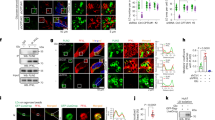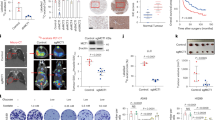Abstract
Peroxisome proliferator-activated receptors (PPARs) are transcription factors that strongly influence molecular events in normal and cancer cells. PPAR-beta/delta (PPAR-b/d) overexpression suppresses the activity of PPAR-gamma (PPAR-g) and PPAR-alpha. This interaction has been questioned, however, by studies with synthetic ligands of PPARs in PPAR-b/d-null cells, and it is not known whether an interaction between PPAR-b/d and PPAR-g exists, especially in relation to the signaling by natural PPAR ligands. Oxidative metabolites of linoleic and arachidonic acids are natural ligands of PPARs. 13-S-hydroxyoctadecadienoic acid (13-S-HODE), the main product of 15-lipoxygenase-1 (15-LOX-1) metabolism of linoleic acid, downregulates PPAR-b/d. We tested (a) whether PPAR-b/d expression modulates PPAR-g activity in experimental models of the loss and gain of PPAR-b/d function in colon cancer cells and (b) whether 15-LOX-1 formation of 13-S-HODE influences the interaction between PPAR-b/d and PPAR-g. We found that (a) 15-LOX-1 formation of 13-S-HODE promoted PPAR-g activity, (b) PPAR-b/d expression suppressed PPAR-g activity in models of both loss and gain of PPAR-b/d function, (c) 15-LOX-1 activated PPAR-g by downregulating PPAR-b/d, and (d) 15-LOX-1 expression induced apoptosis in colon cancer cells via modulating PPAR-b/d suppression of PPAR-g. These findings elucidate a novel mechanism of the signaling by natural ligands of PPARs, which involves modulating the interaction between PPAR-b/d and PPAR-g.
This is a preview of subscription content, access via your institution
Access options
Subscribe to this journal
Receive 50 print issues and online access
$259.00 per year
only $5.18 per issue
Buy this article
- Purchase on Springer Link
- Instant access to full article PDF
Prices may be subject to local taxes which are calculated during checkout





Similar content being viewed by others
References
Bull AW, Steffensen KR, Leers J, Rafter JJ . (2003). Carcinogenesis 24: 1717–1722.
Calnek D, Quaroni A . (1993). Differentiation 53: 95–104.
Chawla A, Repa JJ, Evans RM, Mangelsdorf DJ . (2001). Science 294: 1866–1870.
Fajas L, Egler V, Reiter R, Hansen J, Kristiansen K, Debril MB et al. (2002a). Dev Cell 3: 903–910.
Fajas L, Landsberg RL, Huss-Garcia Y, Sardet C, Lees JA, Auwerx J . (2002b). Dev Cell 3: 39–49.
Febbraio M, Hajjar DP, Silverstein RL . (2001). J Clin Invest 108: 785–791.
Gearing KL, Gottlicher M, Teboul M, Widmark E, Gustafsson JA . (1993). Proc Natl Acad Sci USA 90: 1440–1444.
Girnun GD, Smith WM, Drori S, Sarraf P, Mueller E, Eng C et al. (2002). Proc Natl Acad Sci USA 99: 13771–13776.
Gupta RA, Brockman JA, Sarraf P, Willson TM, DuBois RN . (2001). J Biol Chem 276: 29681–29687.
Gupta RA, Tan J, Krause WF, Geraci MW, Willson TM, Dey SK et al. (2000). Proc Natl Acad Sci USA 97: 13275–13280.
Gurnell M, Wentworth JM, Agostini M, Adams M, Collingwood TN, Provenzano C et al. (2000). J Biol Chem 275: 5754–5759.
He TC, Chan TA, Vogelstein B, Kinzler KW . (1999). Cell 99: 335–345.
Huang JT, Welch JS, Ricote M, Binder CJ, Willson TM, Kelly C et al. (1999). Nature 400: 378–382.
Jimenez B, Volpert OV, Crawford SE, Febbraio M, Silverstein RL, Bouck N . (2000). Nat Med 6: 41–48.
Kliewer SA, Lehmann JM, Willson TM . (1999). Science 284: 757–760.
Kliewer SA, Umesono K, Noonan DJ, Heyman RA, Evans RM . (1992). Nature 358: 771–774.
Matsusue K, Peters JM, Gonzalez FJ . (2004). FASEB J 18: 1477–1479.
Michalik L, Desvergne B, Wahli W . (2004). Nat Rev Cancer 4: 61–70.
Moll R, Zimbelmann R, Goldschmidt MD, Keith M, Laufer J, Kasper M et al. (1993). Differentiation 53: 75–93.
Nagy L, Tontonoz P, Alvarez JG, Chen H, Evans RM . (1998). Cell 93: 229–240.
Nixon JB, Kamitani H, Baek SJ, Eling TE . (2003). Prostaglandins Leukot Essent Fatty Acids 68: 323–330.
Nixon JB, Kim KS, Lamb PW, Bottone FG, Eling TE . (2004). Prostaglandins Leukot Essent Fatty Acids 70: 7–15.
Osawa E, Nakajima A, Wada K, Ishimine S, Fujisawa N, Kawamori T et al. (2003). Gastroenterology 124: 361–367.
Park BH, Vogelstein B, Kinzler KW . (2001). Proc Natl Acad Sci USA 98: 2598–2603.
Peters JM, Aoyama T, Burns AM, Gonzalez FJ . (2003). Biochim Biophys Acta 1632: 80–89.
Pfaffl MW . (2001). Nucleic Acids Res 29: e45.
Renard P, Ernest I, Houbion A, Art M, Le Calvez H, Raes M et al. (2001). Nucleic Acids Res 29: E21.
Rusinol AE, Yang L, Thewke D, Panini SR, Kramer MF, Sinensky MS . (2000). J Biol Chem 275: 7296–7303.
Sarraf P, Mueller E, Jones D, King FJ, DeAngelo DJ, Partridge JB et al. (1998). Nat Med 4: 1046–1052.
Shi Y, Hon M, Evans RM . (2002). Proc Natl Acad Sci USA 99: 2613–2618.
Shureiqi I, Chen D, Lee JJ, Yang P, Newman RA, Brenner DE et al. (2000). J Natl Cancer Inst 92: 1136–1142.
Shureiqi I, Jiang W, Zuo X, Wu Y, Stimmel JB, Leesnitzer LM et al. (2003). Proc Natl Acad Sci USA 100: 9968–9973.
Shureiqi I, Lippman SM . (2001). Cancer Res 61: 6307–6312.
Shureiqi I, Wojno KJ, Poore JA, Reddy RG, Moussalli MJ, Spindler SA et al. (1999). Carcinogenesis 20: 1985–1995.
Stephen RL, Gustafsson MC, Jarvis M, Tatoud R, Marshall BR, Knight D et al. (2004). Cancer Res 64: 3162–3170.
Yu J, Marsh S, Ahluwalia R, McLeod HL . (2003). Cancer Res 63: 6170–6173.
Acknowledgements
We thank Dr Reuben Lotan for his critical review of the manuscript and helpful comments. We also thank Karen Phillips from the Department of Scientific Publications at The University of Texas MD Anderson Cancer Center for editing the manuscript. In addition, we acknowledge the technical assistance of Dongning Chen. This work was supported in part by the National Cancer Institute, National Institutes of Health, Department of Health and Human Services R01 Grant CA104278 (to IS); the American Cancer Society Scholar Award RSG-04-020-01-CNE (to IS); National Institute of Environmental Health Sciences, NIH Center Grant ES07784; and funding from The Jerry and Maury Rubenstein Foundation.
Author information
Authors and Affiliations
Corresponding author
Additional information
Supplementary Information accompanies the paper on the Oncogene website (http://www.nature.com/onc).
Supplementary information
Rights and permissions
About this article
Cite this article
Zuo, X., Wu, Y., Morris, J. et al. Oxidative metabolism of linoleic acid modulates PPAR-beta/delta suppression of PPAR-gamma activity. Oncogene 25, 1225–1241 (2006). https://doi.org/10.1038/sj.onc.1209160
Received:
Revised:
Accepted:
Published:
Issue Date:
DOI: https://doi.org/10.1038/sj.onc.1209160
Keywords
This article is cited by
-
Metabolism pathways of arachidonic acids: mechanisms and potential therapeutic targets
Signal Transduction and Targeted Therapy (2021)
-
The skeletal muscles of mice infected with Plasmodium berghei and Plasmodium chabaudi reveal a crosstalk between lipid mediators and gene expression
Malaria Journal (2020)
-
Self-regulation of the inflammatory response by peroxisome proliferator-activated receptors
Inflammation Research (2019)
-
The role of nuclear receptors in regulation of Th17/Treg biology and its implications for diseases
Cellular & Molecular Immunology (2015)
-
The role of nuclear receptors in regulation of Th17/Treg biology and its implications for diseases
Cellular and Molecular Immunology (2015)



